
back to House of the Sun index

This article is also available in PDF format
|
Most people have never heard of a star constellation named 'The Swan' (Latin name: Cygnus). However in the past this might have been quite different, as there are many fairy-tales, legends and stories about swans related to heroes, knights and gods/goddesses. Wherever swans were living, people had swan stories stretching way back in time, from the Celtic people to Hindus to Siberia. There are a lot of magical happenings surrounding swans, and beings from other dimensions, like the fairies. Swans were highly venerated and associated with high moral and spiritual qualities. A nice overview of swan lore you can find on the website of Justin Swanström. |
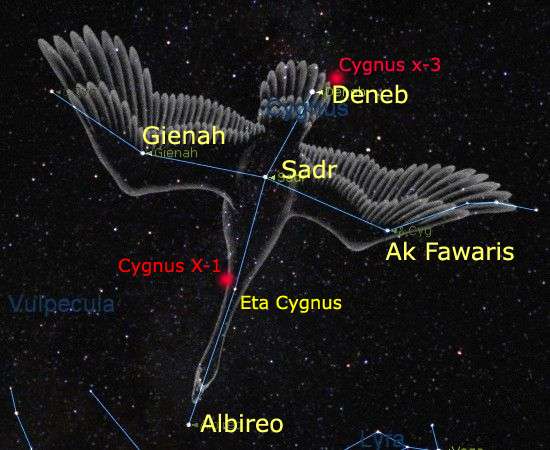 |
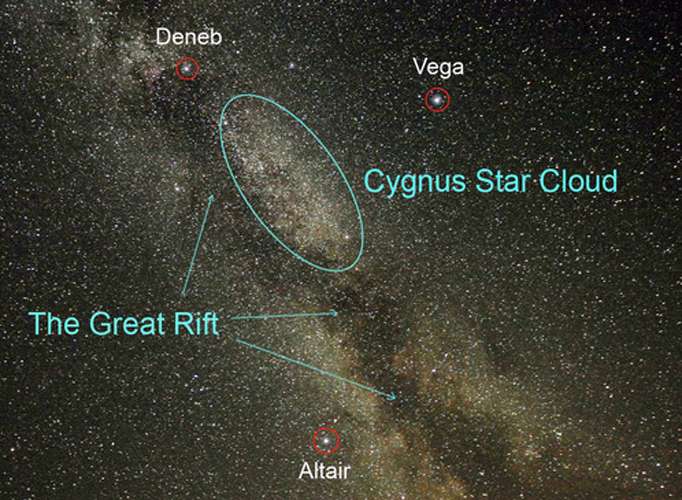 |
|
The constellation of the Swan, or Cygnus, has a special place in the heavens, as it is lying on the plane of the Milky Way. Just west of Deneb, its brightest star, begins “The Great Rift”, a long band of darkness that runs southwest towards the horizon and appears to split the Milky Way in two. The Great Rift is a series of molecular dust clouds located between the solar system and the Sagittarius Arm of the Milky Way Galaxy. Apparently this place in Cygnus, where the Great Rift starts, was seen by shamanic people of different cultures as the place death and rebirth, a gateway to the higher, spiritual realms. Andrew Collins wrote about it in his book The Cygnus Mystery, that you can read on his website. Cultures that didn't know the swan, had another bird representing this constellation, such as the vulture. It is not so much the swan itself that is important, but the symbolism of the bird, regardless the species. In shamanism (taken in its broadest sense of spiritually gifted people), the bird is a symbol of astral flight. A shaman is able to go into an altered state of consciousness and spiritually travel in other dimensions. So the question is why was this part of the cosmos so special that a shaman would direct his consciousness to it for the purpose of astral travel, or spiritually connect with it by other means. |

|
One of the clues might be found in the pyramids of Giza. Anybody who is interested in archeo-astronomy knows that the three pyramids at Giza corresponds with the three bright stars in the belt of Orion. The Orion correlation theory was first put forward by Robert Bauval in 1983. He published this idea in 1989 in the journal Discussions in Egyptology, volume 13. Bauval then wrote The Orion Mystery in 1994. Graham Hancock took up this idea and wrote about it in his books. However Andrew Collins challenged this Orion correlation, pointing out that the star Mintaka (delta Orionis), falls towards the southwest edge of the smallest pyramid and not at its center. It is not an exact match Collins shows that another constellation is an exact match. The three wing stars of the Swan all fall exactly in the center of the three pyramids. It is a better match than the Belt of Orion. So, are the three pyramids actually related to Cygnus? (source: GIZA'S COSMIC BLUEPRINT PART ONE - IS CYGNUS THE KEY TO UNLOCKING THE PYRAMIDS'GRAND UNIFIED PLAN?; and THE CYGNUS-GIZA CORRELATION - THE FACTS AND ALIGNMENTS IN PICTORIAL FORM A Reply to Critics by Andrew Collins) |
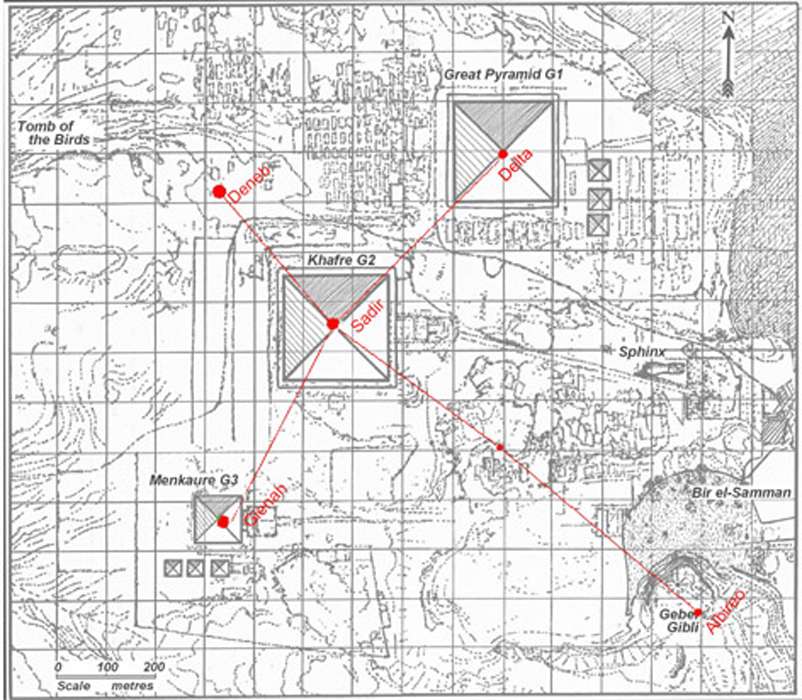
|
So, are the three pyramids actually related to Cygnus? Collins also points out that when you draw an arc of a circle through the center of the three pyramids, then the center of the circle falls at a site called Gebel Gibli, a prominent rocky eminence. |
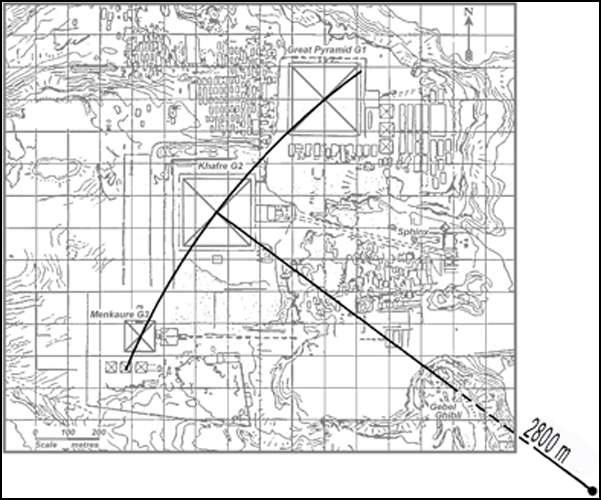
|
From that place, the three Cygnus wing stars can be seen setting down into the peaks of their corresponding pyramids, at c. 2600-2500 BC, the supposed time of their construction. That gives a lot of credence to the Collins's theory of the Cygnus correlation. |

|
In my opinion, the pyramids are much, much older. If we go back one cycle of the precession of the equinoxes (approx. 26,000 years), then we arrive at approx. 30,000 years ago, which is the time of construction of the Great Pyramid that I have come across in other, more esoteric sources. The Bosnian Pyramid of the Sun was built around around that time (26,000 years ago), based on radio-carbon dating of material found underneath the stones. I wonder if the Cygnus correlation of the stars at that time would still hold true, as the motion of the stars do not change much in relation to each other's position in the sky. |
The Architects of the Pyramids

|
When I read about the Cygnus correlation with the three Giza pyramids, I immediately remembered the experience of Hank Wesselman in the King's chamber of the Great Pyramid, in 2003. Sitting on the floor and focusing on the originals architects and builders of the pyramid, he went into an altered state. He found himself on another planet, inside a room, looking out to an alien landscape with two suns in the sky. He realized that he was actually looking through the eyes of one of the planet's inhabitants. You can read the entire story here. His description of those beings is very interesting for several reasons, but in relation to this article and the relationship of the pyramids with Cygnus, it it rather intriguing that these beings had a head resembling a bird! Especially because he wanted to know who the pyramid builders were. It is not a new idea that the architects of the pyramids were extraterrestrial beings, that has been told by psychics and by remote viewers. I first give some of the descriptions from Wesselman, then I will go into a couple of other details relating to the bold emphasis I have made in the quotes. "They were impossibly tall, linear,
and rather spindly humanoids with dark, reddish brown skin.
They were bipedal, and their legs and arms were long, as were their
fingers. Their feet were encased in elegant sandals with turned up toes
that looked like they were made of (or covered by) golden foil. Again,
these beings seemed utterly familiar somehow and I concluded that I was
picking up on the perspective of my ‘host’. The skull was elongated upward and backward, following the direction of the plane of her rostrum, and it was completely hairless. Whatever she was, she was not a typical mammal, despite her ‘breasts’, and my inner scientist decided that these people might be another class of beings altogether." |
Are the Architects Sethians?
|
the Egyptian god Seth |
|
Summarized the 'bird-looking' beings are: tall, linear humanoids had reddish brown skin the face has a 'rostrum' that projects forward and downward eyes are tapering face is elongated The skull was elongated upward and backward Now, as we are talking about Egypt, who in ancient Egypt matches this description? it is... the god Seth. Seth is also spelled Setesh, Sutekh, Setekh, or Suty. |
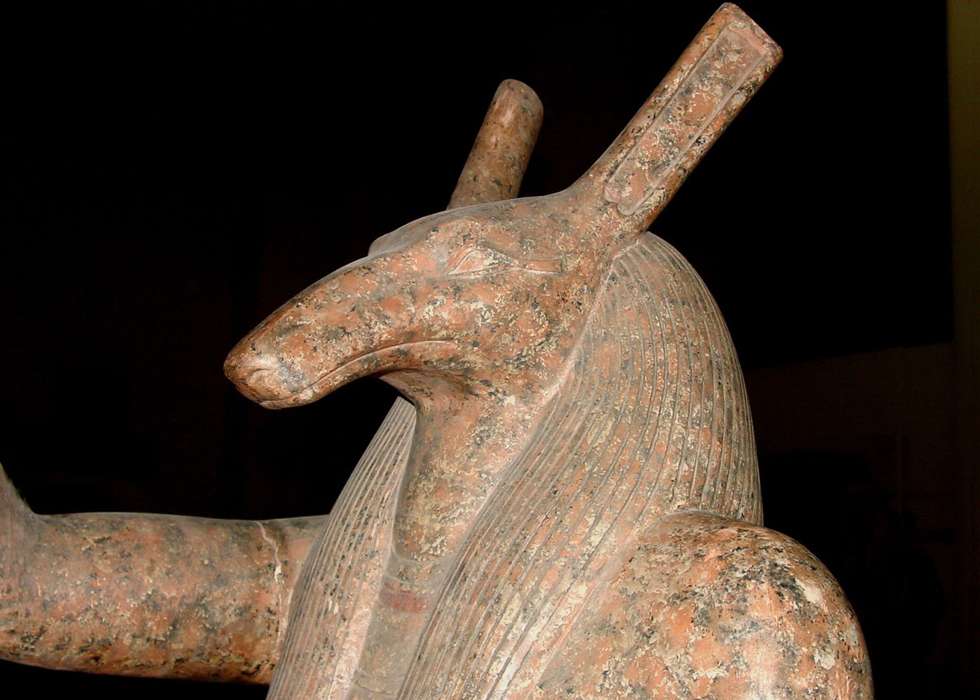 |
|
In ancient Egypt some gods had the head of an animal. Seth is the only one, whose head does not resemble any known animal. So it is quite possible that Seth is a truthful representation of an extraterrestrial species. The Egyptian representation of Seth's head matches very well with the description Wesselman gives of the extraterrestrial architects of the pyramids. Seth is tall, slender. He has a face protrusion that extends forwards and downwards. His eyes are set on the side and all tapered. The only thing you don't quite see is that his head is elongated upward and backward, because he has the typical Egyptian headdress on his head. Seth also had a red skin color. It was said that Seth also had red hair. That is why the Ramses lineage claimed to have been direct descendants of Seth, because they all had red hair themselves. |
Are Sethians from Cygnus?
|
In ancient Egyptian mythology, Seth didn't have a good reputation. He was seen as the god of a lot of unpleasant things, like storms, disorder and violence. In later times, Seth was portrayed as the usurper who killed and mutilated his own brother Osiris. However it seems that all this negativity originally was not present. According to certain researchers, Seth was originally the god of foreigners, and did not have a negative reputation. According to Herman te Velde, the demonization of Seth took place after Egypt's conquest by several foreign nations in the Third Intermediate and Late Periods. It was during this time that Seth was particularly vilified, and his defeat by Horus widely celebrated. I am just speculating here, but did the term 'foreigners' originally mean that Seth was foreign to this planet? Considering that the position of the three pyramids reflect the position of the three wing stars of the constellation of the Swan, is Seth a representation of humanoid beings from Cygnus? |
A Beautiful Depiction of Seth(ians)
|
The above picture of the head of Seth is from a very beautiful granite carving depicting both Seth and Horus performing a ceremony for the pharaoh Ramses III (1186 to 1155 BC). It is made in red granite, almost 2 meters (6.6 feet) high. Originally found at Medinet Habu, now in the Egyptian Museum in Cairo. |
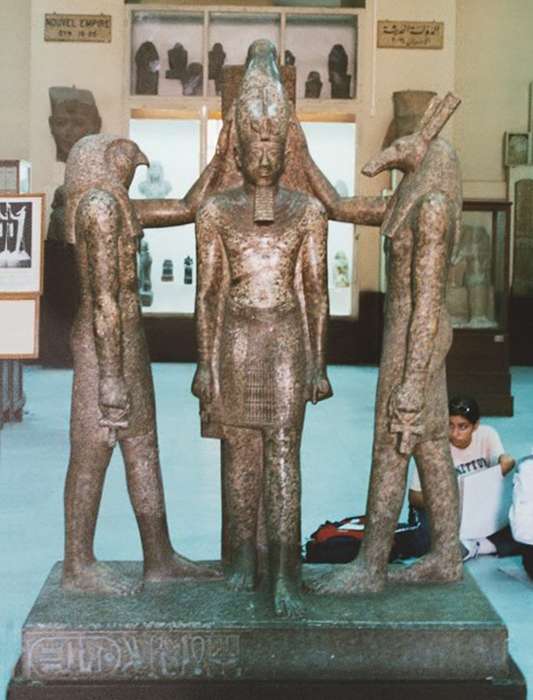 front view |
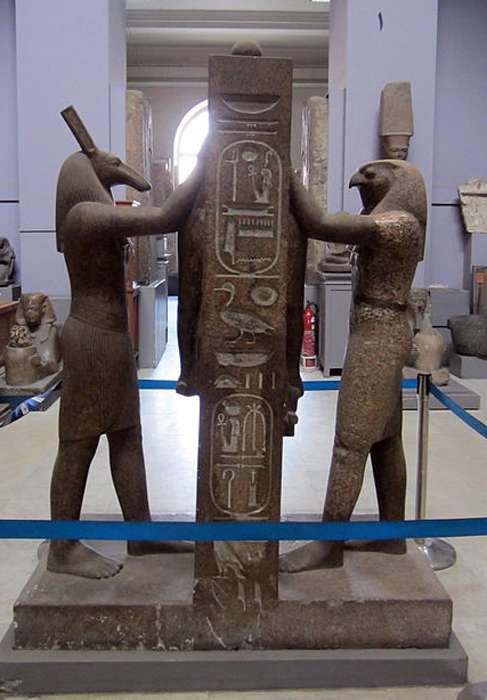 rear view |
 |
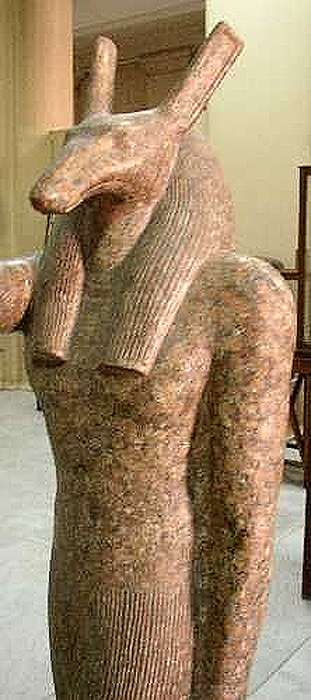 |